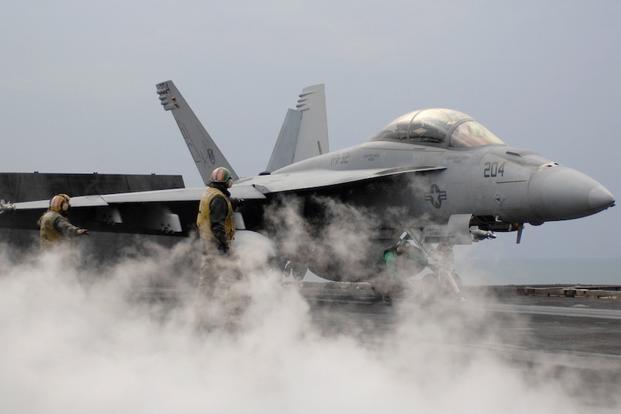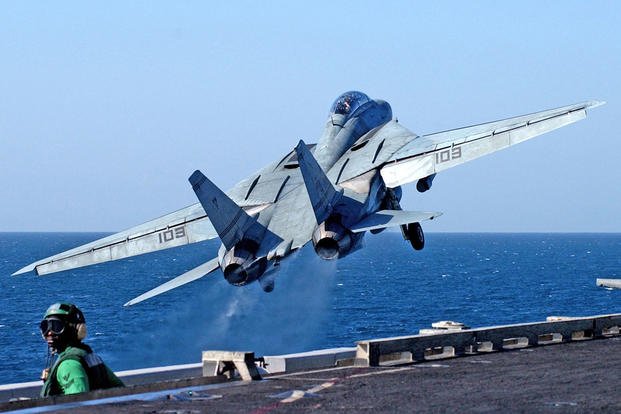Back in the ’80s – before 9/11 when the U.S. military’s focus shifted completely to the Middle East – aircraft carriers used to spend entire deployments in the Mediterranean Sea playing cat-and-mouse with the Soviet Navy, doing bi-lateral exercises with NATO allies, and pulling great liberty in ports like Cannes and Malta.
During that time there was also a persistent pain-in-the-ass Libyan dictator named Moammar Gadhafi.

A few decades before Gadhafi met his untimely demise at the hands of rebels, he made a sport out of provoking the U.S. Navy’s Sixth Fleet assets, primarily by claiming that the entire Gulf of Sidra was territorial Libyan water. He called the line along the northernmost part of the gulf the “Line of Death” and warned that any American ships or airplanes that crossed it would be met with the full force of the Libyan military.
Fighters from the aircraft carrier’s air wing would routinely fly inside the “Line of Death” as part of the American Navy’s “freedom of navigation” operations (aka “FON ops”) designed to prove a commitment to the conventions of international admiralty law that said that the Gulf of Sidra was, in fact, a gulf so therefore the only territorial waters that Libya could claim were those that extended 12 miles off the coastline.
FON ops were generally boring in that the Libyan military didn’t respond at all in spite of Gadhafi’s bluster. Fighters would spend hours on combat air patrol stations drilling holes in the sky without a single vector from the controllers in the early warning aircraft whose radar screens remained blip-free.
But that wasn’t the case on January 4, 1989 when two F-14A Tomcats assigned to “The Swordsmen” of VF-32 got the call to investigate two contacts that had launched out of Tobruk – a dream scenario for Cold War-era aviators, but one that also had a few dubious moments, particularly for the pilot and his radar intercept officer (RIO) in the lead aircraft.

The rules of engagement at that time were more lenient than previous Sixth Fleet rules had been in that a Libyan aircraft didn’t have to fire at an American to be declared hostile but simply if it had turned toward an American aircraft that had attempted to turn away three times.
Analysis of the lead Tomcat’s mission recorder reveals the following (with video time stamp in parenthesis):
(0:11) – The lead RIO transmits “Bogeys have jinked back at me for the fifth time . . .” (Contacts on the F-14’s AWG-9 radar system had a tendency to “windshield wiper” when the aircraft maneuvered, showing erroneous heading changes, but at this point the RIO believes the ROE has been met to declare the Libyans “hostile.”)
(0:19) – Lead RIO transmits “Inside of 20 miles, master arm on,” telling the pilot to flip the switch in the front cockpit. The pilot responds with “good light,” which means the missiles are now ready to fire.
(0:41) – After an exchange between the lead RIO and the wing pilot regarding the bogey’s “angels” (altitude) the lead pilot is less convinced than his RIO that the ROE has been met. He transmits “Alpha Bravo from 207” – an attempt to speak to the admiral on the carrier to get a ruling – but gets no response.
(0:50) – Lead RIO transmits “13 miles . . . Fox-1!” as he pushes the launch button in the rear cockpit and fires an AIM-7M Sparrow missile. His pilot responds by muttering “ah, Jesus” over the intercom, an indication that he’s not entirely comfortable with his backseater’s zeal.
(1:00) – Lead RIO’s excitement gets the best of him, and he shoots a second Sparrow before the first one has time to make it to the target, which prevents either missile from guiding accurately.
(1:13) – Lead RIO calls “six miles” as the wing pilot transmits “tally two” and then says “turning into me.” The crews now know for sure that they’re engaged with MiG-23 “Floggers.”
(1:25) – Lead pilot says, “Okay, he’s got a missile off” over the intercom, referring to the fact his wingman just shot a Sparrow (a forward quarter shot from about 5 miles away).
(1:33) – Lead pilot transmits, “Good hit, good hit on one,” as the wingman’s Sparrow hits one of the MiGs.
(1:39) – Lead pilot says, “I’ve got the other one” as they merge and start a hard turn to get behind the second Flogger. His RIO directs him to “select Fox-2,” meaning he needs to switch the weapons firing control from the radar-guided Sparrow missile to the heat-seeking Sidewinder missile.
(1:48) – Lead RIO says, “shoot ’em!” over the intercom, and the pilot responds with “I don’t got a tone,” which refers to the aural cue that a Sidewinder missile gives the pilot when the seeker senses a heat source. But at this point the pilot doesn’t have a tone because he still has “Sparrow” selected (not “Sidewinder”) on his control stick.
(2:01) – Lead pilot requests that his RIO “lock him up” with the radar – an unnecessary step in Sidewinder firing logic, and the RIO responds with “I can’t. Shoot him, Fox-2!” The pilot, in turn, says, “I can’t. I don’t have a fucking tone.”
(2:04) – RIO starts to command pilot to select the right missile once again, but now the pilot has figured it out. (Fortunately for the American crew the Libyan pilot wasn’t skilled enough to use the American pilot’s “switchology” mistake to his advantage.) The pilot selects “Sidewinder” and the aural tone blares in his headset, indicating the missile is ready to be launched.
(2:06) – Lead pilot transmits “Fox-2” as he fires a Sidewinder missile from about two miles behind the MiG.
(2:09) – Lead pilot transmits “Good kill! Good kill!” as the heads up display shows the second MiG exploding.
While the crews earned the title of “MiG killers,” which makes them part of a rare breed in modern warfare, instructors at the Navy Fighter Weapons School summarized the lead aircraft’s performance as “professionally embarrassing.” (One senior member of the Top Gun staff characterized the shoot down as “punching kids coming off the short bus.”)
It’s also tell-tale that Fighter Pilot of the Year honors that year did not go to the lead pilot – who also happened to be the squadron’s commanding officer – but instead went to the wingman, who was only a first-tour lieutenant at the time.
More articles from We Are the Mighty:
Why getting in trouble early makes you a better leader
The ridiculous anatomy of most Army Reserve drill days
7 real excuses troops use that no NCO ever believes
We Are The Mighty (WATM) celebrates service with stories that inspire. WATM is made in Hollywood by veterans. It's military life presented like never before. Check it out at We Are the Mighty.
















